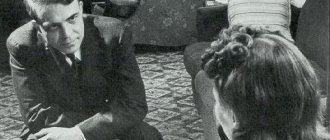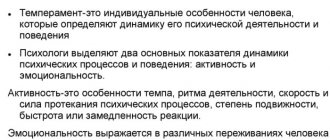Erikson Erik Homberger (1902–1994) is an outstanding psychologist from the United States, the founder and main representative of ego psychology.
The psychologist’s birthplace is Germany, the city of Frankfurt am Main; he spent his childhood in Karlsruhe and studied there.
Later he graduated from the Vienna Psychoanalytic University, and then moved to America. There the scientist worked in Boston and taught at Harvard.
Erickson lived for some time at Yale, then lived and worked in Berkeley for a long time. In 1960 he was appointed professor at the Harvard Institute and retired in 1968. He passed away in America on May 12, 1994.
Erik Homburger Erikson – biographical information
The researcher's fate unfolded in an unusual way. Erikson was born in Frankfurt am Main in 1902. In 1928 he began studying psychoanalysis. He was the son of an extramarital affair between Carla Abrahamsen, a Jewish woman from a wealthy family, and a Danish man. Carla's mother died when she was fifteen. Biographers do not have more information about his father. Since Carla was married to a Jew, Waldemar Salomonsen, the child received the surname Salomonsen. Then Erikson's mother became a nurse, moved to the city of Karlsruhe and remarried. Erik Salomonsen became Erik Homburger, who was adopted by her second husband, pediatrician Theodor Homburger. In 1930, Erikson married Joan Serson, a dancer and artist from Canada, and then moved from Europe to America. Finally, Eric Homburger changes his last name to “Erickson” - “adopting himself,” as he jokingly explained it. And Erickson kept his previous surname as his middle name.
Perhaps it was precisely because of his difficult fate that Erikson was so concerned about the issue of identity. As a child, he was not told about his father. In Jewish schools, Erickson was teased by his peers for his blond hair and blue eyes (“Nordic appearance”), and in secular school, for his Judaism. More and more he realized that his father had non-Jewish roots.
After moving to America, the scientist continued his research at Harvard University and then at Yale. From 1960 to 1968, Erickson worked as a professor at Harvard. Erikson was a student of Anna Freud. But Erickson decided to oppose Freud’s theory with his own. The scientist divided human life not into 5, but into 8 stages. He renamed the “genital stage” “Youth”. Erikson also added three more stages related to the period of adulthood. He believed that the influence of personality development on its formation in society is the merit not of subconscious drives, but of the work of the Ego. Erik Erikson is also the originator of the concept of “Ego Psychology.” In it, the Ego is not the servant of unconscious impulses. Erickson was convinced that it was the human Ego that was responsible for organizing life, communicating with people, and personal growth.
Death
Erik Erikson died on May 12, 1994. The cause of death turned out to be diseases associated with old age. He found his last refuge in the city of Harwich, in Massachusetts. The psychologist and his wife are buried in the Congregational Church cemetery.
Erikson
Posted by Cynthia Moore Friday, November 29, 2021
The grave of Erik Erikson and his wife.
The scientist’s works are in demand to this day, and his photos are placed in textbooks and books on developmental psychology.
Erikson's stages of personality development
Erikson divided personality development into eight stages, during which the process of ego identity formation unfolds.
- The first stage - infancy - lasts from birth to 1 year. The basic crisis is the formation of trust or distrust in the outside world. The source of energy here is hope. Alienation provokes temporary confusion.
- Early childhood stage – from 1 year to 3 years. The basic crisis is the opposition of personal autonomy to doubt and shame. The source of energy is will, and alienation occurs due to distorted self-awareness.
- Stage 3 to 6 years, or play age. The crisis consists of a conflict between initiative and a sense of guilt. The source of energy at this stage is the ability to formulate goals and objectives. Alienation occurs due to the rigid predetermination of the social role.
- From 6 to 12 years old, the child is at the school age stage, when failure is opposed to competence. A potential source of energy for the psyche here is confidence, and alienation is provoked by stagnation of activity.
- Next comes the stage of adolescence, which Erikson ranged from 12 years to 21 years. It is here that the confrontation between identity and role confusion occurs. The crisis is expressed by the question: who am I? The teenager strives for independence and wants to be free from responsibility for his life. Adolescence is the age during which the future professional development of the individual is determined, and attempts are made for the first time to build a romantic relationship.
- The stage of early maturity lasts from 21 to 25 years. Here, intimate relationships are contrasted with isolation. The question at this age is: am I able to build trusting relationships with others?
- The stage of middle maturity lasts from 25 to 60 years. It contrasts stagnation in action with productive life. The question that expresses the basic conflict of this age is what does my life mean? What am I going to do with it?
- The eighth stage is called the late maturity stage. It involves a process that Erikson’s theory of personality development calls ego integration. The question of this period was: did my life have meaning?
Contribution to science
Erikson's basic personality theory explains existing normal, adequate states, and also explains pathological, unhealthy variations in possible situations. The doctrine of this researcher is a textbook for psychologists, psychotherapists and anyone interested in psychological issues.
Identity is the central definition, according to Erikson. Personal identity is a set of traits or character traits that help a person become different from other members of society; these qualities are the “highlight” of a person.
Ego identity is a present but deceptive sense of the individual's integrity and independence, a sense of constancy and immutability of the inner Self.
We recommend: Personality Psychology
Group identity is a sense of belonging to a social group. Ego identity and group identity are formed and developed throughout a person's life.
Erikson identified the main age periodization of personality development and formation:
1. Infancy (basic trust or lack thereof): lasts from birth until the baby is one year old. At a very early stage of development, the foundations of trust and a sense of security are laid through maternal care. If the mother rejects the child and takes poor care of him, then fear and mistrust are formed in the baby.
2. Very early childhood (independence or feelings of shame and doubt): lasts from one to three years. The foundation for the baby’s independence is formed, his horizons expand, and the child gradually learns to control himself. If there is too much guardianship or, conversely, unjustified expectations of relatives, uncertainty, a feeling of shame or doubt arises in the child.
3. Playing period (initiative or guilt): lasts from three to six years. During this age period, the child actively explores the world and acquires new skills. Society expects him to be active, he has responsibilities towards himself, and sometimes towards younger children or pets. Parents who encourage their child's curiosity help them become independent. And those who limit create passivity and guilt in him.
4. School age (industriousness or inferiority): lasts from six to twelve years. During this period, children learn discipline, consistency, get involved in work, and expand their knowledge and experience. If you do not support your child, he may develop feelings of inferiority and insecurity in front of his friends.
We recommend: Read more about age-related crises
5. Adolescence/gradual maturation (ego identity or shifting social roles): the main stage, according to Erikson. This is the period of formation of the basic positive ego identity. The future of a person takes on clearer outlines and becomes realistically feasible. Adolescents learn new social roles, but if their mastery is unsuccessful, role displacement occurs.
6. Youth/Maturity (Intimacy or Isolation): Lasts from about age twenty to age twenty-six. Intimacy refers to the feeling of closeness that we show towards our family and dear people. If attempts to make contact or establish relationships fail, loneliness and isolation arise.
7. Maturity (performance/activity or inertia): lasts up to 64 years. During this age period, people take care of the younger generation and try to be useful. When there is a feeling of uselessness or absence of an object of care, inertia and passivity are formed.
8. Old age (ego-integrity or despair): from 65 years. A number of new problems arise: illness, lack of strength, constant fatigue, pain. We have to get used to the new mental state. Reflections on approaching death. An analysis of past stages of life takes place. In old age comes true wisdom and understanding of what is happening.
We recommend: Francis Galton (biography)
At almost every stage of life, an individual faces various crises, which, according to Erikson, must be successfully overcome.
Erik Erikson and his books made a huge contribution to the development of psychology. In them, people can find answers to many life questions in brief or complete formulation.
Erikson's Theory of Personality Development and Ego Identity
What does the term mean that Erickson was so interested in that he devoted much of his research to it? Strictly speaking, identity is the identity of a person with himself. Erikson sought to expand this concept. Identity, he believed, is both an image of oneself in relation to the world around us, and a person’s ability to qualitatively solve the difficulties that arise before him, and an indicator of the maturity of the individual.
Transitions between stages of personality development are crises. But they are not neurotic in nature, but are only turning points in development. Erikson's special attitude towards adolescence can be seen in many of his works. At this stage, the scientist believed, the deepest psychological crisis occurs. Three powerful forces lead to it: physiological maturation, problems communicating with peers, and professional choice.
Erickson gave a special name to the period between adolescence and adulthood - mental moratorium. The course of this crisis largely depends on the previous stages. The result of adolescence is either a mature personality or a personality with a “diffuse identity.” If the crisis of adolescence has not been overcome, then the result is pathological development of the individual. It is expressed in the following characteristics:
- Increased, persistent feeling of anxiety;
- Feeling of loneliness and emptiness;
- Reluctance to take responsibility; the desire to delay the acquisition of adult status for as long as possible;
- Social fears, as well as the inability to interact emotionally with people of the opposite sex;
- Denial of the value of all social roles, including male and female.
The period of adulthood is also of particular importance for ego identity. If a person does what he loves and has managed to build a family, this is a good sign. If he is lonely, he does not have a good job or a satisfying hobby, stagnation begins. The individual experiences emotional and physiological stress.
Scientific activity
Erikson teaches at a private school in Vienna, where he meets Anna Freud, the daughter of Sigmund Freud. It is she who kindles his interest in psychoanalysis, and Erikson goes to comprehend this science at the Vienna Institute of Psychoanalysis.
In 1933, while he was studying at the institute, the Nazi Party came to power in Germany, and Erikson had to flee the country. First, he goes to Denmark, and then moves to the USA, where he becomes the first child psychoanalyst in Boston.
After working there for some time, Erickson changed positions in various institutions, including the Massachusetts General Hospital, the Judge Baker Center for Family Education, Harvard Medical School and the Psychological Clinic, etc.
In 1936, Erickson taught at Harvard Medical School and also worked at the Institute of Interpersonal Relations at this university. He also finds time to teach a group of children on the Sioux Reservation in South Dakota.
In 1937 Erickson leaves Harvard and joins the staff of the University of California. He works closely with the Institute for Social Protection of Children and is engaged in private practice. Erickson devotes part of his time to teaching children of the Yurok tribe.
In 1950, his personal experiences with people of different races living in different social conditions led to the writing of the most famous book of his entire scientific career, Childhood and Society. In this book, the author presents to the world his own theory of “personal crisis.”
After leaving the University of California, Erickson began working and teaching at the Austen Riggs Center, the premier psychiatric treatment facility in Stockbridge, Massachusetts. There, due to the nature of his activity, he encounters mentally unbalanced teenagers.
In 1960, Erikson returned to Harvard University, where he would work until retirement, after which, together with his wife, he would begin writing papers on various topics in psychology.
What is Ego Integration?
The feeling of ego integration is the feeling of the integrity of one’s “I”. Initially, children do not have a sense of “I”. For them, the world around them and themselves are one and the same. The famous psychologist Jean Piaget emphasized that infants have no personality boundaries. They begin to form only by 2-3 years.
The highest level of personal development is a state when the world for a person becomes an ideal place to satisfy his needs (both spiritual and lower order). This state is called integration in psychology. From an evolutionary point of view, it means the highest degree of fitness.
The integrated personality is a clipboard between society and the inner world. She is able to avoid harmful factors, enhance beneficial ones, and even turn evil into good. A high degree of integration is characterized by professional development of the individual at a serious level.
According to Erikson, ego integration arises as a property of late life. But only if a person was able to experience numerous victories and defeats during his life and was an inspiration for others. Ego integration of an elderly person is a look at the past years and their positive assessment: “I am satisfied with the life I have lived.” Such people are not afraid of death. Indeed, in their descendants or creative achievements, they were able, in a certain sense, to gain immortality.
On the other side of the barricades are those who have “wasted their lives.” They look at the time they have lived with regret: it now seems like a series of missed opportunities. At the end of their lives, they feel that it is too late to start something. Erikson's theory of personality development identifies two types of mentality in such people. First, they regret that life cannot be lived again. Secondly, they deny their own shortcomings, projecting them onto the world around them. “Despair means that there is too little time left to choose another path to wholeness; That’s why old people try to embellish their memories,” Erikson writes in his works. Feelings of anxiety and self-pity in their extreme cases lead to mental disorders in old age. These are hypochondria, paranoia, depression and dementia.
Direction in psychology
Erik Erikson's seminal work is Childhood and Society (1950). This book draws heavily on the practice of psychoanalysis. Since psychoanalysis has always been aimed at studying mental disorders, the book describes various conflict situations as examples. This work is about childhood and historical processes.
Erikson's theory largely deals with the development of the ego (self). However, the scientist stated that his theories are a continuation of the psychosexual ideas of S. Freud, and they will help in further psychosocial development and in conducting research in the field of biology and sociology.
The psychologist introduced the concept of “ego psychology,” which revealed the role of the Ego in a person’s life. The scientist believed that only the Ego is responsible for the quality of life, for physical and spiritual harmony, for the healthy socialization of a person.
As Erikson stated, the ego determines a person's identity and self-esteem. The inner human “I” is the source of all victories and defeats, joy and sorrow.
It was extremely important for the psychologist to study the Ego and its adaptive abilities when various emotions arise: apathy, fear, aggression. Due to the development of various disorders and crises of a psychological nature in humans, the scientist searched for and selected psychological methods that could effectively help the patient
For example, consultations with a psychologist, therapy, medications, hypnosis
Due to the development of various disorders and crises of a psychological nature in a person, the scientist searched for and selected psychological methods that could effectively help the patient. For example, consultations with a psychologist, therapy, medications, hypnosis.
We recommend: Identification is
Erikson described the main 8 age stages of personality formation, and this became a significant contribution to the study of the human psyche. This teaching is familiar to any professional psychologist.
The scientist tried to demonstrate the influence of culture that it has on the stages of the formation of an individual, and this served as a fulcrum for many researchers studying personality behavior patterns, creating original methods for studying psychological questions that people ask today.
The scientist invented his own concept of psychological development of the individual and divided it into eight stages, somewhat similar to Freud’s diagram of the development of the individual. Erickson only added three new stages of formation.
Erikson wrote that all manifestations must be recognized within the framework of the interrelationship of biology, behavior, perception and society.
The theoretical orientation of Erikson's teachings includes:
- Analysis of the changes that accompany a person throughout his life, starting from childhood.
- Emphasis on the healthy mental state of people, rather than on the pathological one.
- The study of the Ego, which determines a person’s self-identity and individuality.
- Relating clinical findings to cultural and historical phenomena.
- Interpretation of the stages of development and formation of the human psyche.
- Creating methods to help other scientists and psychologists.
Freud and Erikson: theoretical differences
Erikson himself insisted that his concepts were nothing more than a continuation of Freud's psychoanalytic theory. But in fact, he moved so far away from it that in modern science Erikson’s theory is considered separately. What is the difference between the views of Freud and Erikson on personality development, human character and its formation in the process of life?
- Freud gave the main role in personality development to unconscious drives, or Id. He was convinced that it was the conflict between the unconscious and social restrictions that was the cause of all diseases and neuroses. Erikson insisted on the dominant role of the ego, due to which Erikson’s theory was called “Ego psychology.” Freud believed that the Ego is a component that, as if between a rock and a hard place, is trying to reduce the restrictions of society and the drives of the Id. Erickson believed that the ego is a separately functioning system that works with the outside world through perception, thinking, memory and attention.
- Freud's and Erikson's views on the parental role in character formation differ. The development of personality is influenced to a greater extent by the conditions in which a person was born and lives, and the historical era. Erikson came to this conclusion by observing the development of children in different cultures. The scientist was sure that the Ego inevitably develops and changes under the influence of external conditions.
Erikson's theory of personality development differs from Freud's concept in understanding psychosexual conflicts. Freud focused on the influence the unconscious has on human life. He was also convinced that the cause of adult conflicts was unresolved childhood trauma. Erikson, on the contrary, placed the main emphasis on understanding the adult as an individual who can cope with difficulties. His theory is centered on the concept of the Ego with all its virtues, which are revealed in the process of life.
Biography
Erickson's fate is peculiar. He was born as the result of an extramarital affair between his mother, Carla Abrahamsen, of Jewish descent, and a Danish citizen (there is no further information about Erikson's father beyond his last name). Carla Abrahamsen came from a prominent Jewish family originating from the northern German lands. Her father, Joseph, was a dried fruit merchant in Copenhagen, and her brothers Einar, Nikolai, Max and Axel were involved in charity work (including a kitchen for poor immigrants from Russia, mostly Jews). Her mother, Henrietta, died when Carla was 15 years old.
Since Carla was officially married to Valdemar Isidor Salomonsen (a stockbroker of Jewish origin), the child was recorded as Erik Salomonsen. After some time, she trained as a nurse, moved to Karlsruhe and in 1904 married pediatrician Theodor Homburger. In 1909, Erik Salomonsen became Erik Homburger, and in 1911 he was officially adopted by his stepfather. Although her husband adhered to Conservative (not Orthodox) Judaism, Carla insisted on strict adherence to Jewish ritual in the family, including kosher meals, holidays, and weekly attendance at synagogue on Fridays and Saturdays. In addition to secular education, children received Jewish education. Moreover, Karla headed the branch of the League of Jewish Charity of Baden at the local synagogue.
The issue of identity crisis has much to do with Erikson's own life experiences. Information about his biological father was hidden from him in childhood. At the Jewish religious school he was teased for his “Nordic” appearance (he was tall, blue-eyed, blond), and at the regular school for his Jewish religion. Over the years, he became increasingly tormented by the suspicion that his father was not of Jewish origin.
In 1930, Eric Homburger married Canadian dancer and artist Joan Mowat Serson and emigrated from Vienna to the United States in 1933. Somewhat later, his sisters emigrated: Ruth Hirsch settled in New York and Ellen Katz in Haifa. In the late 1930s, Erik Homburger officially changed his last name to Erikson (by adopting himself, as he explained it), while keeping his former last name as his middle name.
Erikson contrasted Freud's theory, which divided psychological development into five stages, with his own scheme, in which there were eight such stages. Erikson renamed the so-called “genital stage” “adolescence” and also added three more adult stages.
Erikson also owns the concept of “ego psychology,” emphasizing the role of the Ego as something more than the “handmaiden of the Id” (in Freudian ideas). According to Erikson, it is the Ego that is responsible for organizing life, for ensuring harmony with the physical and social environment, for healthy personal growth; it is a source of self-confidence and personal identity.
In 1950, he became a victim of the “witch hunt” (McCarthyism) in the United States, as he was suspected of communist sympathies. When Berkeley professors were required to sign a loyalty oath, Erickson left the university, after which he worked for ten years at a clinic in Massachusetts and another ten years at Harvard.
In 1970, Erickson was awarded the Pulitzer Prize for non-fiction for his book Gandhi's Truth.
Conclusion
No matter how much Erikson's theory of personality development is opposed to Freud's psychoanalysis, they also have something in common. In both theories, the stages of human development are predetermined. The order in which they are completed also remains unchanged. Erikson was convinced that conflicts in previous stages could also occur in subsequent stages. The eight tasks that Erikson identified in his theory are solved throughout life. If a person was unable to cope with any crisis in a timely manner, he has a chance to do it later - but with great effort. After all, every period of life “throws up” new difficulties. According to Erikson, a crisis is not a disaster, but just a turning point. It can both maladapt a personality and be a source of strength.
Topic: Personal growth
School age
The fourth period corresponds to the ages of 6 to 12 years and is chronologically similar to the latent period in Freud's theory. Rivalry with a parent of the same sex has already been overcome, the child leaves the family and becomes familiar with the technological side of culture.
The term “hard work”, “taste for work” reflects the main theme of this period; children at this time are absorbed in the fact that they strive to find out what comes out of what and how it works. The child's ego identity is now expressed as: “I am what I have learned.” While studying at school, children are introduced to the rules of conscious discipline and active participation. School helps the child develop a sense of hard work and achievement, thereby reaffirming a sense of personal strength. The ritual associated with school routines is perfection of execution.
Having built in the early stages feelings of trust and hope, autonomy and “will power,” initiative and determination, the child must now learn everything that can prepare him for adult life.
If a child is encouraged to tinker, do handicrafts, cook, is allowed to finish what he has started, and is praised for his results, then he develops a sense of competence, “skill,” confidence that he can master a new task, and his abilities for technical creativity develop.
If parents or teachers see the child’s work as mere pampering and an obstacle to “serious studies,” then there is a danger of developing in him a feeling of inferiority and incompetence, doubts about his abilities or status among his peers. At this stage, the child may develop an inferiority complex if adults' expectations are too high or too low.
The question answered at this stage is: Am I capable?
Proceedings
Major works
- Childhood and Society
(
1950 ) - Young Luther.
Historical-psychoanalytic study (
Young Man Luther. A Study in Psychoanalysis and History
) (1958) - Gandhi
's Truth: On the Origin of Militant Nonviolence
( 1969) - Adulthood
(
editor
, 1978) - Vital Involvement in
Old Age
( with the participation of JM Erikson and H. Kivnick, 1986)
The Life
Cycle Completed
( featuring JM Erikson, 1987)
Collections (in English)
- Identity and the Life Cycle. Selected Papers
(1959) - A Way of Looking at Things: Selected Papers 1930–1980
(Editor: SP Schlien, 1995) - The Erik Erikson Reader
(Editor: Robert Coles, 2001)
Bibliography in Russian
- Erickson E.
Identity: youth and crisis / Transl. from English; total ed. and preface A.V. Tolstykh. - M.: Progress, b.g. (1996). - Erickson E. G.
Childhood and society / Transl. and scientific ed. A. A. Alekseev. - St. Petersburg: Summer Garden, 2000. - Erickson, E. G. Young Luther. Psychoanalytic Historical Research / Erik G. Erikson; Per. from English A. M. Karimsky. - M.: Moscow Philosophical Foundation "Medium", 1996. - 560 p.
Playing age, preschool age
The third period is the “age of play,” from 3 to 6 years. Children begin to become interested in various work activities, try new things, and communicate with peers. At this time, the social world requires the child to be active, solve new problems and acquire new skills; he has additional responsibility for himself, for younger children and pets. This is the age when the main sense of identity becomes “I am what I will be.”
A dramatic (game) component of the ritual develops, with the help of which the child recreates, corrects and learns to anticipate events.
Initiative is associated with the qualities of activity, enterprise and the desire to “attack” a task, experiencing the joy of independent movement and action. The child easily identifies himself with significant people, readily lends himself to training and education, focusing on a specific goal.
At this stage, as a result of the acceptance of social norms and prohibitions, the Super-Ego is formed, and a new form of self-restraint arises.
Parents, encouraging the child’s energetic and independent endeavors, recognizing his rights to curiosity and imagination, contribute to the development of initiative, expanding the boundaries of independence, and the development of creative abilities.
Close adults who severely limit freedom of choice, overly control and punish children cause them to feel too much guilt.
Children overwhelmed by guilt are passive, constrained and have little ability for productive work in the future.
Infancy
From birth to one year is the first stage in which the foundations of a healthy personality are laid in the form of a general sense of trust.
The main condition for developing a sense of trust in people is the mother’s ability to organize the life of her small child in such a way that he has a sense of consistency, continuity and recognition of experiences.
An infant with an established sense of basic trust perceives his environment as reliable and predictable. He can bear the absence of his mother without undue distress and anxiety about being “separation” from her. The main ritual is mutual recognition, which persists throughout subsequent life and permeates all relationships with other people.
The methods of teaching trust or suspicion in different cultures do not coincide, but the principle itself is universal: a person trusts the world around him, based on the degree of trust in his mother. A feeling of mistrust, fear and suspicion appears if the mother is unreliable, incompetent, or rejects the child.
Mistrust can intensify if the child ceases to be the center of her life for the mother, when she returns to previously abandoned activities (resumes an interrupted career or gives birth to another child).
Hope, as optimism regarding one’s cultural space, is the first positive quality of the ego acquired as a result of the successful resolution of the trust/distrust conflict.
Part I. Childhood and modalities of social life.
Chapter 1. Relevance and relativity in medical history.
In every field of activity there are several very simple, but extremely inconvenient questions, since the ongoing disputes around them lead only to endless failures and consistently put most specialists in a stupid position. In psychopathology, such questions have always concerned the localization and cause of the neurotic disorder. Does it have a visible beginning? Is its cause in the body or in the soul, in the individual or in society?
For centuries, this question has been at the center of church discussions about the origins of madness. Was the cause of madness the possession of the devil or acute inflammation of the brain? Such a simple opposition now seems outdated. In recent years, we have come to the conclusion that neurosis turns out to be a psychosomatic, psychosocial, and even interpersonal phenomenon.
However, the discussion most often shows that these new definitions are just different combinations of such independent concepts as psyche and soma, individual and group. We now say “and” instead of the exclusive “or,” but we retain at least the semantic assumption that the soul is a “thing” separable from the body, and society is a “thing” outside the individual.
Psychopathology is a product of medicine, which had its famous origin in the search for the location and causation of illness. Our scientific community is dedicated to this quest, which instills in both those who suffer and those who heal the magical confidence that comes from scientific tradition and prestige. This approach convinces us to consider neurosis a disease, since neurosis supposedly causes pain. Indeed, neurosis is often accompanied by definite (localizable) bodily suffering, and we have clearly defined approaches to illness, both at the individual and at the epidemiological level. And these approaches have led to a sharp decline in some diseases and a reduction in mortality from others.
However, something strange is happening. When we try to think of neuroses as diseases, we gradually come to reconsider the problem of disease as a whole. Instead of approaching a more precise definition of neurosis, we find that certain widespread symptoms, such as pain in the heart and stomach, take on a new meaning when they are considered neurotic symptoms, or at least symptoms of central rather than peripheral disturbances in isolated organs.










